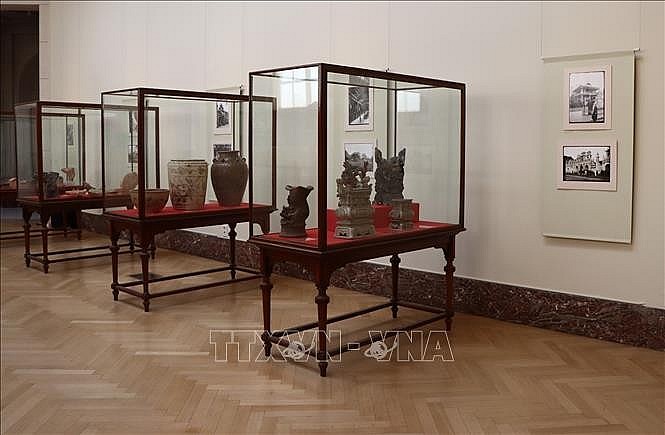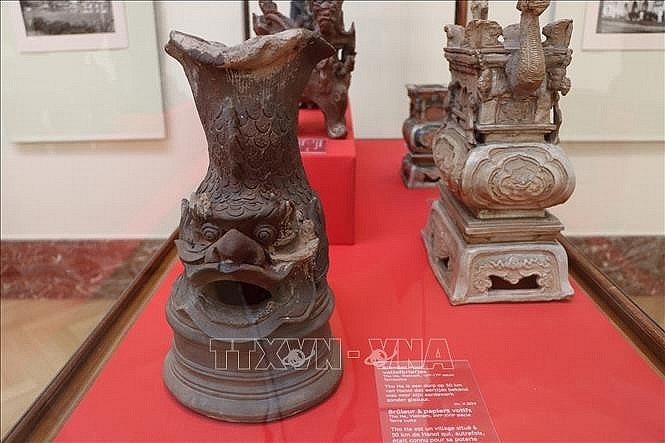 |
| Vietnamese antiquities at the Royal Museum of Art and History in Brussels. (Photo: VNA) |
Entering the Southeast Asia section of the museum, visitors are immersed in an exciting journey. From the cultures of Cambodia, Thailand, Myanmar, Laos, Indonesia, to Vietnam, the space is adorned with the traditional specialties of the Southeast Asian countries, such as the Indonesian gamelan orchestra, images of Buddhas, and ancient bronze drums.
The Vietnam section is filled with nearly 3,000 artifacts dating back to the 15th century, making it the largest collection of Vietnamese antiquities abroad. Clément Huet, who purchased the collection in 1952, worked in Vietnam from 1914 to 1938. Huet collected many Vietnamese cultural artifacts such as ceramics, statues, jewelry, weapons, and ceremonial objects. The collection provides a unique overview of Vietnamese culture and art before the 20th century.
Bowi Quibus, in charge of the Southeast Asia exhibit area, said the artifacts are arranged according to two main criteria: chronology and theme, in order for visitors to easily follow the development of Vietnamese art and culture and better understand the country’s history and culture.
Tourists begin their journey to discover Vietnam from the first civilizations, with artifacts belonging to the Dong Son culture in the North, Sa Huynh in the Central, and Oc Eo in the South. In this section, there are stone jewelry, stone axes, bronze daggers, and fired ceramic statues on display. Next, the ceramic jars ceramic vases of Sa Huynh culture, and earthen earrings dating from the 3rd century AD, which were donated to the museum by the Belgian-Vietnamese Chamber of Commerce, are introduced to the visitors.
 |
| Furnace to burn votive paper – Tho Ha ceramic product, dated 16th-7th centuries. (Photo: VNA) |
They can also find the ancient ceramic artifacts excavated in Go Hoi (Binh Dinh) by the Royal Museum of Art and History of Belgium in collaboration with the Vietnam Institute of Archeology and Binh Dinh General Museum in 2002, including a 5-point millet, a pile of broken baked dishes, cups, plates, and bowls demonstrating the sophisticated crafting techniques and high-quality ceramics of this period.
The gallery’s highlight is the Dong Son bronze drums, a unique cultural symbol of Vietnam. Besides, visitors can also admire the painted ceramic masterpieces of the Ly and Tran dynasties; monochrome ceramics and delicate blue ceramics.
Logan Vander Linden, a Belgian tourist, said he was excited to learn about Vietnamese antiques at the museum, from the way they are displayed to the information about their origin and meaning. Thereby, he gained a better understanding of Vietnam’s history.
To preserve the massive collection of antiques, the museum has installed a temperature and humidity sensor system to monitor environmental conditions and adjust the temperature and lighting to ensure that the artifacts are not affected by external factors.
The collection of Vietnamese antiquities at the MRAH museum is an introduction to the rich cultural and artistic development of Vietnam through dynasties. This is an ideal destination for tourists to learn about the country and people of Vietnam.
MRAH Museum was founded in 1835 and currently houses a massive collection of more than 800,000 artifacts in art, history, and archeology from around the world.
The Ancient Rocky Ground in Sapa
The ancient rocky ground in Sapa was recognized by the Ministry of Culture, Sports and Tourism as a national historical relic. Vietnam also completed a profile to submit to UNESCO for recognizing it as a world’s cultural heritage. For nearly 18 years, the ancient rocky ground has attracted many archaeologists both at home and abroad who want to research and decode the mysterious patterns of the ancient Vietnamese engraved on boulderss.
Have A Wonderful Trip To Co Loa Citadel – The Historical Site In Vietnam
Co Loa unique national relic is located in Dong Anh district, Hanoi. This place is not only a cultural heritage, a proof of the creativity, technical level as well as the culture of the ancient Vietnamese people, but also an ideal destination for tourists from all over the world.






